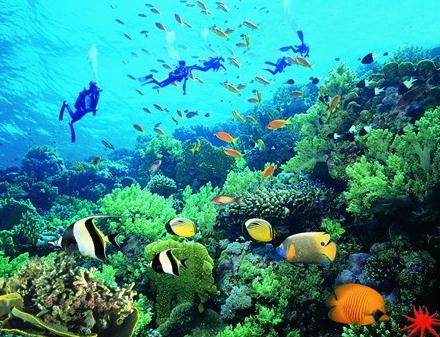Listen to part of a lecture in a marine biology class.
聽(tīng)一段海洋生物課。
So we have been fairly thorough in our discussion about coral reefs, which of course are prominent, oceanic features made of hard limestone skeletons produced by tiny coral animals.
我們對(duì)珊瑚礁的討論已經(jīng)很透徹了,當(dāng)然了,珊瑚礁具有顯著的海洋特征,由小型珊瑚動(dòng)物制造的石灰骨架構(gòu)成。
We've gone over where coral reefs are usually formed – along the edges of shallow ocean banks in tropical or subtropical regions, and the fact that they are declining at an alarming rate.
我們已經(jīng)講過(guò)珊瑚礁主要分布在熱帶或亞熱帶地區(qū)的淺海沿岸的哪些地方,和珊瑚礁數(shù)量正在快速下降,令人憂心。
But I don't want to leave you with the impression that all is lost.
但我不想讓你們覺(jué)得,什么都沒(méi)有了。
There are several techniques being employed today that could prove useful in assuring the future of the reefs.
今天人們運(yùn)用了一些技術(shù),經(jīng)過(guò)檢驗(yàn),能有效保證珊瑚礁的未來(lái)。

Now, we've talked in depth about coral bleaching, or whitening, which as you recall, is a symptom of … well, that the coral is suffering.
我們已經(jīng)深入地談過(guò)珊瑚的漂白現(xiàn)象,或說(shuō)變白現(xiàn)象,而這正如你們所記得的,是一種癥狀……珊瑚正在受苦。
As you know, coral is very sensitive to water temperature, even though one or two degree Celsius rise in sea surface temperature for a relatively short amount of time can cause bleaching.
正如你們所知,珊瑚對(duì)水溫是很敏感的,哪怕只是海水表面溫度在相對(duì)短的時(shí)間內(nèi)上升一兩度華氏度,也會(huì)造成珊瑚漂白。
Recently, researchers have used data collected by monitoring surface water temperatures to improve the ability of a reef to recover from bleaching.
最近,研究人員通過(guò)監(jiān)測(cè)表面水溫獲得數(shù)據(jù),并用此數(shù)據(jù)來(lái)提升珊瑚礁從漂白狀態(tài)中恢復(fù)的能力。
One future possibility is that improved monitoring can help predict where and when bleaching will occur, which might potentially enable us to mitigate its effects.
未來(lái)的一種可能是,升級(jí)后的監(jiān)測(cè)有助于預(yù)測(cè)漂白現(xiàn)象發(fā)生的時(shí)間和地點(diǎn),這也許能讓我們減輕漂白現(xiàn)象的影響。
And there's another technique that's been experimented with to try to help coral reefs recover from bleaching.
人們還嘗試了另一種技術(shù),試圖幫助珊瑚礁從漂白中恢復(fù)。
It's called coral transplantation.
這項(xiàng)技術(shù)叫珊瑚移植。
This involves moving young coral from a healthy reef onto a degraded reef, you know, in an attempt to regenerate the degraded reef by encouraging young healthy coral to take over.
這項(xiàng)技術(shù)就是把年輕珊瑚從健康的珊瑚礁移到退化的珊瑚礁上,想以此鼓勵(lì)年輕健康的珊瑚接手,幫助退化珊瑚礁再生。
There has been some success with this, but it's still somewhat controversial.
這項(xiàng)技術(shù)已經(jīng)取得了一定成就,但還存在一定的爭(zhēng)議。
Some scientists support it because, well, for one thing, it means you don't have to rely on the existing coral to reestablish itself because it might not be able to.
一些科學(xué)家持支持態(tài)度,因?yàn)椋环矫妫@意味著你不用依賴(lài)于現(xiàn)存珊瑚的自我重建,因?yàn)楹芸赡芩霾坏健?/p>
But in my opinion, transplanting coral should only be used as … well, as a last resort.
但我認(rèn)為,移植珊瑚只能用在……這是下策。
I mean, this method is not only costly but it's … well, even if it's successful, it still fails to address the ongoing problem, the root causes of the degradation, which really is paramount to devising an effective solution.
我是說(shuō),這個(gè)方法不僅成本很高,而且……即使成功了,也沒(méi)能解決長(zhǎng)久以來(lái)存在的問(wèn)題——退化的根源,要想找出一個(gè)有效的解決方案,這是很重要的。










